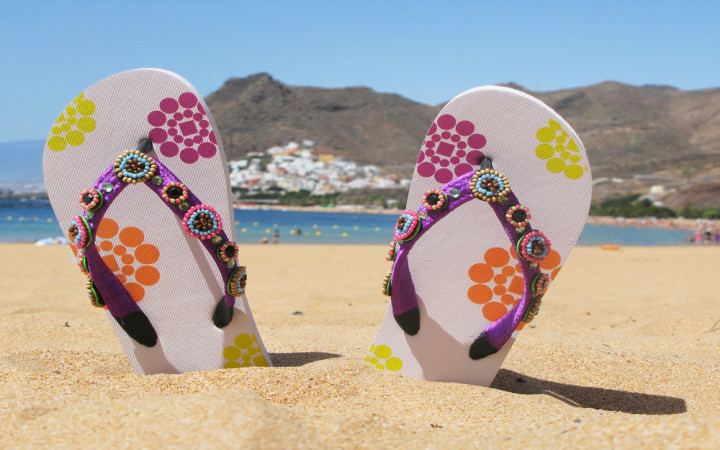On beaches and at pools around the world, children and adults of all ages wear simple shoes that consist of a thin rubber sole with a y-shaped strap that goes across the top of the foot and between the first (“big") and second toes. Yes, we're talking about flip-flops!
All you need to do to figure out why we call them "flip-flops" is to walk around in a pair of them for just a little while. Because of how they're made, the rubber soles slap against the bottom of your feet as you walk, making a flip-flop, flip-flop sound. The name “flip-flop" is thus an example of onomatopoeia.
Onomatopoeia means a word or a thing's name comes from the sound that it makes. Other examples of onomatopoeia include moo, buzz, quack, zip, and beep. Say each of these words. Can you hear how the word sounds like what it describes?
Not everyone around the world calls them "flip-flops," though. In New Zealand, they're called "jandals" (short for Japanese sandals). They're "thongs" in Australia and "plakkies" in South Africa. Even some areas of the United States have special names for them, such as "zories" on the East Coast, "clam diggers" in Texas, and "slippers" in Hawaii.
Although the name “flip-flops" originated in America in the 1950s, flip-flops go way, way back in time. Experts believe flip-flops have been around for at least 6,000 years. Ancient Egyptian murals on tombs and temples show flip-flops were worn around 4,000 B.C.
In Japan, shoes similar to flip-flops are called zori. They are traditionally worn by Japanese children when learning to walk. People believe flip-flops first appeared in America after World War II, when returning soldiers brought zori back from Japan as souvenirs. Flip-flops then became even more popular after soldiers returned from the Korean War in the 1950s.
Although flip-flops began as just a summer shoe popular with surfers and those spending time near the water, today they're as common as tennis shoes and blue jeans. Modern stores carry a wide variety of styles, and flip-flops are as common at the mall as they are at the pool or the beach.
Although many people find flip-flops quite comfortable, foot doctors will warn you not to wear them too often or for extended periods of time. Flip-flops do not provide ankle support. In addition, their overall lack of foot support has been linked to several different foot-related problems, such as overpronation and tendonitis.




